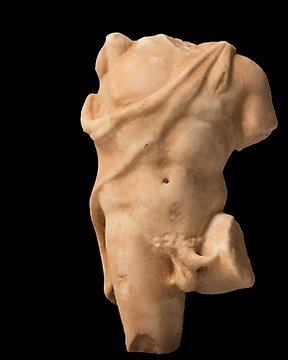
Epoca Romanilor Marmură Tors satir. secolele I - II d.Hr. 14 cm. H. Foarte frumoasa miscare
Nr. 79303025

Nr. 79303025

HEAD OF VENUS CROUCHED
- nice decorative fragment -
Roman Empire, 1st century AD
Marble.
Dimensions: 21 cm height with stand, 12 cm height without stand.
Condition: Good condition, not restored.
Provenance: Private collection, A.D., Brussels. Acquired from Peter Sloane Objects & Worts of Art, London, in 1994. Retains a copy of the invoice.
Private collection, Estepona, Malaga. Purchased from previous owner.
Fragmented head of the goddess Venus from a full-length sculpture that would belong to a typology that presents the crouching goddess (Vénus Accroupie), squatting, completely nude. She represents a moment in which she is surprised during the bath, or else she is engrossed contemplating her reflection in the water. It is a type of Hellenistic Greek origin, attributed to Doidalsas of Bithynia. It was a very popular model, as indicated by the large number of Roman copies that have survived to this day.
The piece under study reflects a face with a relaxed expression, large eyes and a slightly open mouth, delicate and naturalistic. Due to its dimensions, it cannot be considered an image of public or private worship; Possibly it is a work intended for the field of decoration and ornament, since this motif became very popular as a decoration for thermal baths in Roman times.
Aphrodite was the Greek goddess of beauty, love, fertility, and she embodied the primordial forces of Creation. From the 3rd century B.C. she will be identified by the Romans with Venus, a local divinity related to the same powers. The goddess, according to Hesiod, was born from the foam—the sperm—that originated in the sea around the severed genitalia of Ouranos. At the origins of the universe, Uranus (Heaven) joined Gaea (Earth), producing various children, but for fear that they would dethrone him, he kept them locked up in his mother's bosom. Crono, fed up with this situation, seized power by castrating his father and throwing his sex into the sea:
«From the foam and in the middle of it a maiden was born. She first sailed towards the divine Cythera and from there she later headed for Cyprus... she The august and beautiful goddess came out of the sea, and under her delicate feet the grass grew around [...]. She was accompanied by Eros and followed by the beautiful Himeros at first when she was born, and then on his march to the tribe of the gods. And these attributions she possesses [...]: intimacies with maidens, smiles, deceit, sweet pleasure, love and sweetness ».
PARALLELS:
Fig. 1 Venere Accovacciata. Roman Empire, s. I AD, Carrara marble. Gallerie degli Uffizi, Firenze (Italy), cat. 1914 no.188.
Fig. 2 Statuette head of Venus. Roman Empire, s. III AD, marble. Musée du Louvre, Paris, inv. Ma 5063.
Notes:
- The piece includes authenticity certificate.
- The piece includes Spanish Export License (Passport for European Union). NOT TAXES.
- According to Spanish legislation, items sent outside the European Union are subject to export taxes and will be added to the invoice, at the buyer's expense. These export fees are fixed on the final auction price and the tax rate is not applied directly on the total value of the item to be exported, but rather the different percentages by sections are applied to it:
- Up to 6,000 euros: 5%.
- From 6.001 to 60.000 euros: 10%.
This export permit application process can take between 1-2 months maximum.
- The seller guarantees that he acquired this piece according to all national and international laws related to the ownership of cultural property. Provenance statement seen by Catawiki.
#MorganNiquetCollection
Cum să cumperi de la Catawiki
1. Descoperă ceva special
2. Plasează cea mai mare ofertă
3. Fă o plată sigură